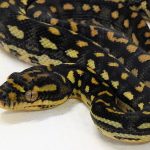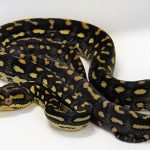DIAMOND PYTHON
Diamond Python
In the lush forests and woodlands of southeastern Australia, a remarkable creature slithers through the underbrush and climbs the towering trees—the Diamond Python (Morelia spilota spilota). This non-venomous snake, renowned for its striking appearance and beneficial role in the ecosystem, captivates both wildlife enthusiasts and casual observers alike.
Physical Characteristics
Imagine a snake with a deep, dark olive to black body, each scale adorned with a central yellow or cream spot. These spots often form intricate patterns resembling diamonds, giving the Diamond Python its name. The underside is typically white or cream, sometimes tinged with yellow, and often speckled with black. Adult Diamond Pythons usually measure around 2 meters in length, though some individuals can grow up to 3 meters. Females are generally larger than males, with some reaching lengths up to 4 meters.
Habitat and Distribution
The Diamond Python is primarily found in the southern coastal regions of New South Wales and the eastern parts of Victoria. It inhabits a variety of environments, including forests, woodlands, and even urban areas. These adaptable snakes are often seen in suburban settings, where they help control populations of rats and other vermin.
Behaviour and Diet
As semi-arboreal creatures, Diamond Pythons are adept climbers, often found basking in trees or shrubs. They are primarily nocturnal, using their camouflage to ambush prey such as small mammals, birds, and lizards. They kill their prey by constriction, wrapping around it and squeezing until it suffocates.
Reproduction
Diamond Pythons are oviparous, with females laying between 10 to 50 eggs per clutch. After laying, the female coils around the eggs to protect them and maintain warmth through muscular contractions. This maternal care continues until the hatchlings emerge, after which the female departs.
Conservation Status
While the Diamond Python is not currently considered endangered, it faces threats from habitat destruction due to urban development and land clearing. In Victoria, the subspecies is listed as threatened, highlighting the need for conservation efforts to preserve their natural habitats.
Human Interaction
Diamond Pythons are generally non-aggressive and pose little threat to humans. They are often found in suburban areas, where they help control populations of rats and other vermin. If you encounter one, it’s best to observe from a safe distance and allow the snake to continue its natural activities.
Conclusion
The Diamond Python is a testament to the resilience and adaptability of Australian wildlife. Its unique appearance and ecological role make it a fascinating subject of study and a valuable component of its native ecosystem. By understanding and appreciating these remarkable creatures, we can contribute to their conservation and ensure that future generations can marvel at their beauty and significance.


